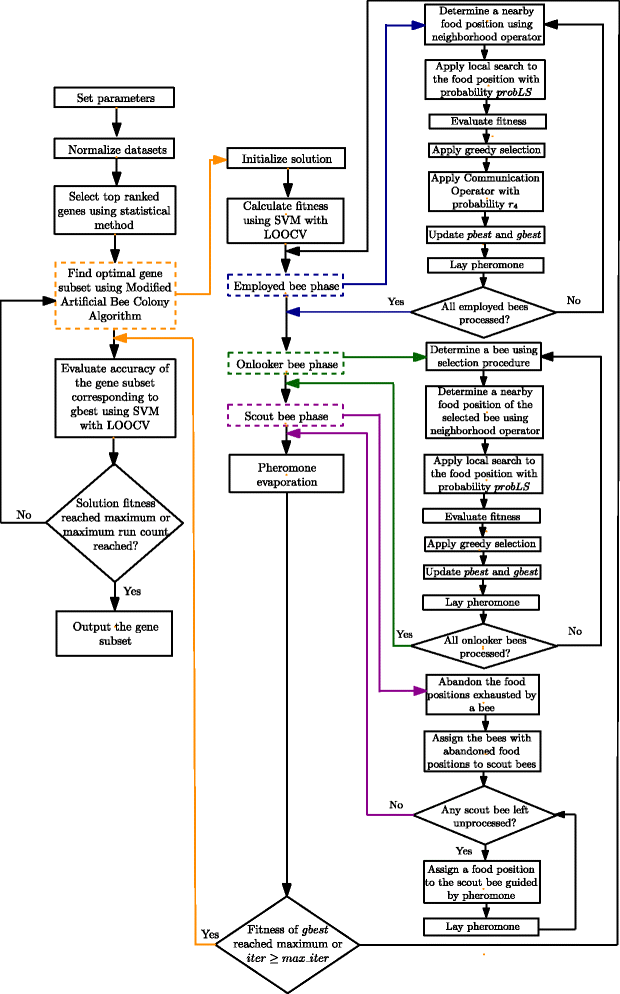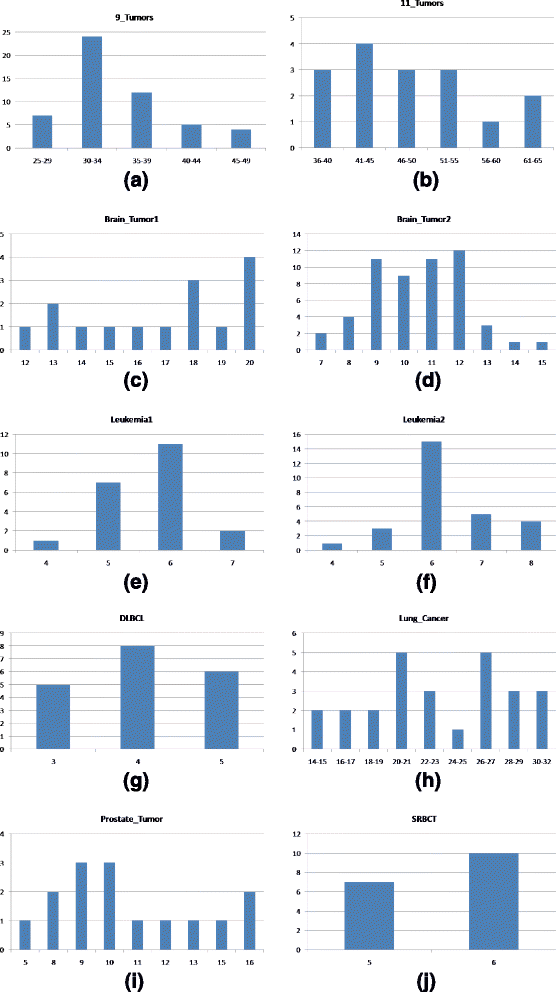Gene selection for cancer classification with the help of bees
- PMID: 27510562
- PMCID: PMC4980787
- DOI: 10.1186/s12920-016-0204-7
Gene selection for cancer classification with the help of bees
Abstract
Background: Development of biologically relevant models from gene expression data notably, microarray data has become a topic of great interest in the field of bioinformatics and clinical genetics and oncology. Only a small number of gene expression data compared to the total number of genes explored possess a significant correlation with a certain phenotype. Gene selection enables researchers to obtain substantial insight into the genetic nature of the disease and the mechanisms responsible for it. Besides improvement of the performance of cancer classification, it can also cut down the time and cost of medical diagnoses.
Methods: This study presents a modified Artificial Bee Colony Algorithm (ABC) to select minimum number of genes that are deemed to be significant for cancer along with improvement of predictive accuracy. The search equation of ABC is believed to be good at exploration but poor at exploitation. To overcome this limitation we have modified the ABC algorithm by incorporating the concept of pheromones which is one of the major components of Ant Colony Optimization (ACO) algorithm and a new operation in which successive bees communicate to share their findings.
Results: The proposed algorithm is evaluated using a suite of ten publicly available datasets after the parameters are tuned scientifically with one of the datasets. Obtained results are compared to other works that used the same datasets. The performance of the proposed method is proved to be superior.
Conclusion: The method presented in this paper can provide subset of genes leading to more accurate classification results while the number of selected genes is smaller. Additionally, the proposed modified Artificial Bee Colony Algorithm could conceivably be applied to problems in other areas as well.
Keywords: Artificial bee colony algorithm; Cancer classification; Evolutionary algorithm; Gene selection; Microarray.
Figures



Similar articles
-
Genetic Bee Colony (GBC) algorithm: A new gene selection method for microarray cancer classification.Comput Biol Chem. 2015 Jun;56:49-60. doi: 10.1016/j.compbiolchem.2015.03.001. Epub 2015 Mar 18. Comput Biol Chem. 2015. PMID: 25880524
-
mRMR-ABC: A Hybrid Gene Selection Algorithm for Cancer Classification Using Microarray Gene Expression Profiling.Biomed Res Int. 2015;2015:604910. doi: 10.1155/2015/604910. Epub 2015 Apr 15. Biomed Res Int. 2015. PMID: 25961028 Free PMC article.
-
A Hybrid Gene Selection Method Based on ReliefF and Ant Colony Optimization Algorithm for Tumor Classification.Sci Rep. 2019 Jun 20;9(1):8978. doi: 10.1038/s41598-019-45223-x. Sci Rep. 2019. PMID: 31222027 Free PMC article.
-
A novel gene selection algorithm for cancer classification using microarray datasets.BMC Med Genomics. 2019 Jan 15;12(1):10. doi: 10.1186/s12920-018-0447-6. BMC Med Genomics. 2019. PMID: 30646919 Free PMC article.
-
Gene Selection via a New Hybrid Ant Colony Optimization Algorithm for Cancer Classification in High-Dimensional Data.Comput Math Methods Med. 2019 Oct 13;2019:7828590. doi: 10.1155/2019/7828590. eCollection 2019. Comput Math Methods Med. 2019. PMID: 31737086 Free PMC article.
Cited by
-
A gene selection algorithm for microarray cancer classification using an improved particle swarm optimization.Sci Rep. 2024 Aug 23;14(1):19613. doi: 10.1038/s41598-024-68744-6. Sci Rep. 2024. PMID: 39179674 Free PMC article.
-
A graph-based gene selection method for medical diagnosis problems using a many-objective PSO algorithm.BMC Med Inform Decis Mak. 2021 Nov 27;21(1):333. doi: 10.1186/s12911-021-01696-3. BMC Med Inform Decis Mak. 2021. PMID: 34838034 Free PMC article.
-
ClusterMine: A knowledge-integrated clustering approach based on expression profiles of gene sets.J Bioinform Comput Biol. 2020 Jun;18(3):2040009. doi: 10.1142/S0219720020400090. J Bioinform Comput Biol. 2020. PMID: 32698720 Free PMC article.
-
A comparative study of machine learning and deep learning algorithms to classify cancer types based on microarray gene expression data.PeerJ Comput Sci. 2020 Apr 13;6:e270. doi: 10.7717/peerj-cs.270. eCollection 2020. PeerJ Comput Sci. 2020. PMID: 33816921 Free PMC article.
-
Deep gene selection method to select genes from microarray datasets for cancer classification.BMC Bioinformatics. 2019 Nov 27;20(1):608. doi: 10.1186/s12859-019-3161-2. BMC Bioinformatics. 2019. PMID: 31775613 Free PMC article.
References
-
- Fodor SP. DNA sequencing: Massively parallel genomics. Science. 1997;277(5324):393–5. doi: 10.1126/science.277.5324.393. - DOI
-
- Golub TR, Slonim DK, Tamayo P, Huard C, Gaasenbeek M, Mesirov JP, Coller H, Loh ML, Downing JR, Caligiuri MA, et al. Molecular classification of cancer: class discovery and class prediction by gene expression monitoring. Science. 1999;286(5439):531–7. doi: 10.1126/science.286.5439.531. - DOI - PubMed
Publication types
MeSH terms
Grants and funding
LinkOut - more resources
Full Text Sources
Other Literature Sources

